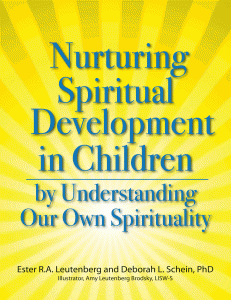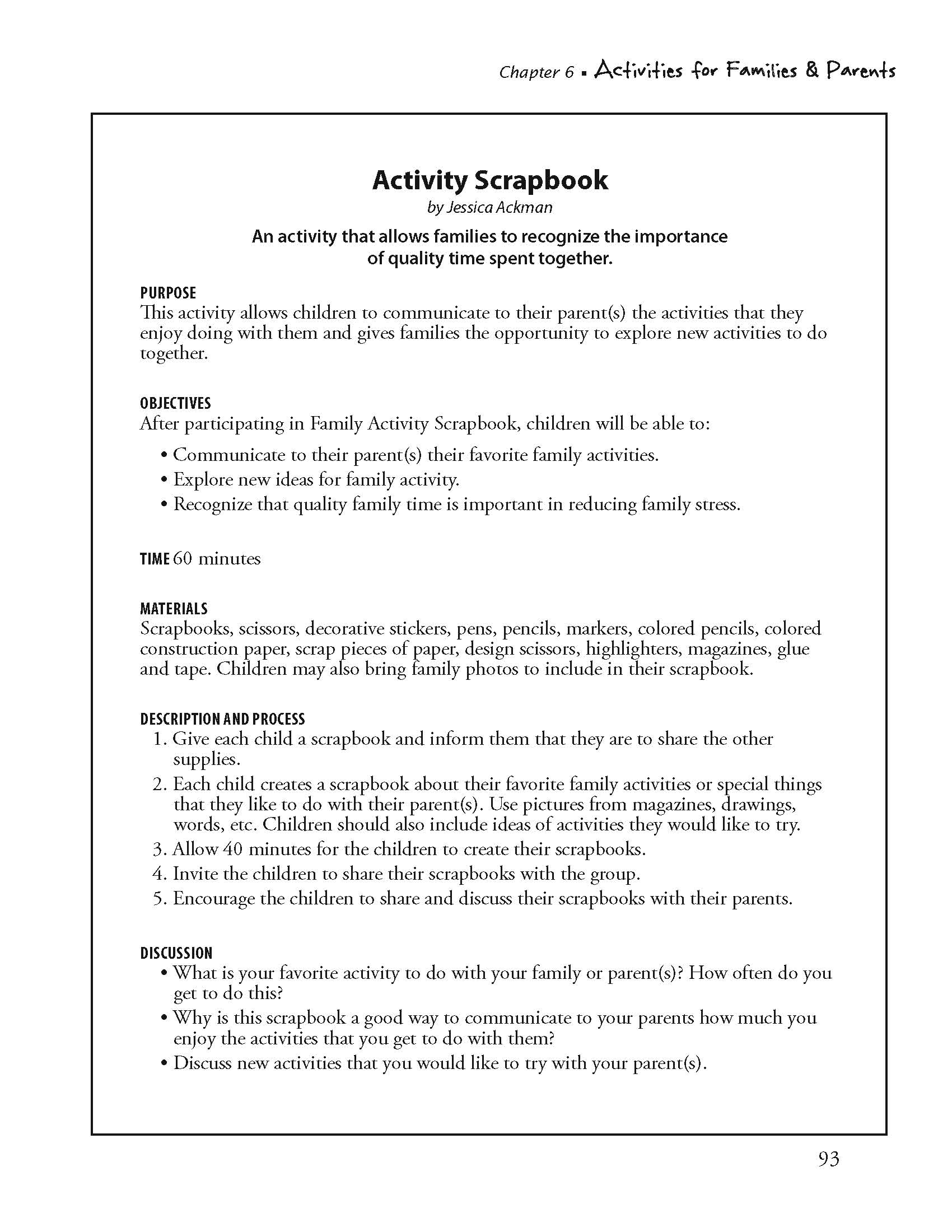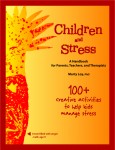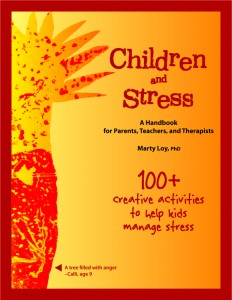Spiritual Moments
Excerpted from Nurturing Spiritual Development in Children by Understanding Our Own Spirituality
By Ester R.A. Leutenberg and Deborah L. Schein, PhD
Introduction
Caregivers should be aware of the importance of spirituality and to realize that spiritual development can be nurtured at very young ages.
In this blog the term caregiver refers to biological, adoptive, step or foster parents; family members; child-care educators; day-care workers and nannies; and other people who are in the position of being responsible for the care of young children.
A caregiver can begin instilling spirituality even before a child is born. Singing and other sounds are felt as vibrations and possibly as sounds by a fetus in the womb. During this time frame, an infant is most vulnerable to the environment. A baby absorbs and adapts to time, place, region, and local norms and culture. The spiritual embryonic phase begins here and continues throughout one’s lifetime.
Spiritual development is vital for all caregivers. There are aspects of spiritual development that are common to all people. The intent of the authors is to provide opportunities to evoke and strengthen each caregiver’s spiritual development, and ultimately, influence the spiritual development of the children to whom the adults are giving care. Readers will find information about various aspects of spiritual development. Caregivers are encouraged to spend time in reflection and journal writing. This will provide opportunities to evoke and strengthen the spiritual development that will enhance the spiritual development of the children the adults are nurturing.
Truisms – Young Children and Spiritual Development
- Spirituality is an innate human trait.
- This innate trait must be nurtured in order to flourish.
- All children require love and attachment at the beginning of life to awaken this innate spirituality, so that it can be nurtured and developed.
- All children need interesting and beautiful spaces in which to experience life. This space can be as big as a park, and as small as a corner of a room.
- Young children are extremely competent learners because they have absorbent minds with exceptional ability to learn culture, language, and nuances from the environment and the people in that environment.
- Spiritual development plays an important role in promoting learning and growth for all children, and is inter-related with all other domains of development.
- Children will develop spirituality far more easily when the adults in their lives are spiritually grounded.
Important definitions to keep in mind:
Complex disposition is reflected in how one acts toward others by caring, kindness, empathy, and reverence.
Basic disposition is the internal feeling triggered by moments of wonderment, awe, joy, or inner peace.
Spiritual Moments Happen Every Day
 I was co-writing a book about spirituality and on the way to a restaurant with friends, I asked the husband if he was religious, spiritual, spiritual and religious, or none of them. He gave me a confused look, and said, “What is spirituality?” I told him that it is different for everyone. I said, “For me, when I look at the mountains beyond my backyard, I have a sense of wonderment, of being a small part of the universe. It swells my heart.” His response was, “I have no idea what you are talking about.” We enjoyed our dinner, saying no more about it.
I was co-writing a book about spirituality and on the way to a restaurant with friends, I asked the husband if he was religious, spiritual, spiritual and religious, or none of them. He gave me a confused look, and said, “What is spirituality?” I told him that it is different for everyone. I said, “For me, when I look at the mountains beyond my backyard, I have a sense of wonderment, of being a small part of the universe. It swells my heart.” His response was, “I have no idea what you are talking about.” We enjoyed our dinner, saying no more about it.
Driving home, he said he had been thinking. When he was at Machu Picchu, atop the Andes Mountains in Peru, he recalled an unbelievable feeling of awe. He reflected at that time upon his wonderment of the world. In the twenty-five minutes it took us to drive home, he told a half a dozen other stories like that. His wife’s mouth was wide open. She, in fifty years of marriage, had never heard these stories. That one question opened him up to reflect and to recognize his spiritual moments and to consider his own spirituality.
~ Ester R.A. Leutenberg
Spiritual Moments in Time
Spiritual moments in time are quiet, calm moments with extended time for children to play and explore – these moments are most felt when children live their lives within a set routine and within environments that provide order. Such environments invite children to predict, know, and feel secure within a day, a week, or more.
Think about moments that have given you feelings of peace and contentment; moments when you felt as if time was simply stretched out before you and you had no need to hurry.
- What are you doing in these reflective moments?
- What ties these reflective moments together?
Click here to for a printable worksheet.
Spiritual Moments in Space
Spiritual moments in space describe young children’s play environments that are aesthetically pleasing and a beautiful space where real objects, real experiences, and rich language are intentionally provided. This type of environment is often filled with moments of wonder, awe, joy, and inner peace that can fill each child’s basic disposition.
- What would you consider to be a beautiful learning space. What qualities would that space need?
Click here to for a printable worksheet.
Spiritual Moments in Relationships
Most children enjoy interactive relationships that are not stagnant, but that change in ways that stimulate their senses, intellect, and inner person. Such moments can help children to strengthen their will to self-regulate, be mindful, and take on responsibilities such as caring for a plant or garden, a pet, or helping to keep a room clean and organized.
We all have special people in our lives.
- Think about the special people who were important to you as a young child. What made them so important to you?
- Who are the special people in your life now and what makes them so important to you?
- Describe how the qualities of the important people in your life, from your childhood to now, are the same or how they have changed.
Click here to for a printable worksheet.
Spiritual Moments in and with Nature
Many research studies have been conducted on nature’s impact on human development. Kindness, respect, empathy, harmony, and being welcoming to others, are just a few of the benefits children engage in as they experience the natural world. As they explore the outdoors with nature, nature is also brought indoors for close-up exploration. Spiritual life begins with a sense of wonder, and one of the first windows leading to wonder is the natural world. In general, nature is an amazing source for wonder, awe, joy, inner-peace, and relationships. It eventually provides an environment for the emergence of big questions.
Go for a walk outdoors and look for moments that touch you spiritually.
- Why do you think this is happening?
- Try to put words to your feelings.
Click here to for a printable worksheet.
Spiritual Moments with Big Questions
Big questions are capable of taking one beyond oneself. When one engages in big questions, one is able to feel one’s own place within the universe. If one believes in transcendence, then a big question can take the person to that place. If one does not, the big question can provide feelings of humility, smallness, and a feeling of a place within the vastness of the universe.
Young children are capable of big questions, also. You can see the question in a child’s body posture, eyes, and expression. Through exploration of the world a myriad of questions come alive for a child. It is through big questions that a child is capable of seeing that the world exists way beyond oneself.
We all have big questions about life and how we see ourselves in the big picture!
People often have big questions involving these aspects of life:
- Spiritual Moments
- Caregiver Love
- Self-Awareness
- Mindfulness and Mindsight
- Disposition
- Wonder
- Kindness
- Openness and Imagination
- Gratitude
- Breath and Presence
- The Big Picture: Spiritual Development
Although children may not be able to completely articulate their big questions, they hold curiosities and questions about how life works.
Examples might be:
- Where does the sunlight come from?
- Why does light go away at night?
- Where do my shadows come from?
- Who creates a rainbow?
- An example of a big question from an adult might be:
- What happens to a person when the person dies?
A Big Question can lead you to explore spirituality from a personal perspective.
- What is one of YOUR big questions about life in general
- that in some way involves one or more of the items listed on the prior page?
- Why is this big question important to you?
Click here to for a printable worksheet.
The Relationship of Rituals and Spiritual Moments
A ritual is a ceremony or regular occurrence consisting of a series of actions performed according to a prescribed order and a set time. Some common rituals are saying good morning to someone when waking up, or singing a song to a child before going to bed. One’s life is filled with rituals that strengthen one’s spirituality.
- What are some rituals that were shared with you as a child?
- At the time, how did you feel about those rituals?
- How did it make you feel to participate in those rituals?
- How do rituals strengthen your spirituality?
- What are some of the rituals you share with a child in your life?
Click here to for a printable worksheet.
Spiritual Moments: Thought-Provoking Quotations
Spiritual moments happen every day. All you need to do is to know how and when to recognize them.
~ Ester R.A. Leutenberg
Spiritual moments are created in relationships with others, in awareness and appreciation of self, in and with nature, and in dialogue with big questions capable of taking one beyond oneself.
~ Deborah L. Schein
Click here to for a printable worksheet.
Spiritual Moments
Ideas, Activities, and Moments for All Caregivers to Share with Children
Spiritual moments can sometimes happen by chance. More often, though, they need to be created by establishing nourishing connections. Here are some ways to provide spiritual moments for the children you know, and for yourself as well. Such moments can strengthen the spiritual development of everyone. • Answer questions in a patient, thoughtful way.
- Ask the child to tell you a story. Then, ask questions about it.
- Breathe slowly with a young child, putting each of your hands on each other’s heart.
- Clean up toys together.
- Create time in the day to simply be with the child.
- Dance together.
- Discuss the importance of friendship.
- Encourage quiet time.
- Enjoy reading with a child.
- Find a caterpillar and wonder together where it came from and what it will become.
- Find a spider’s web and talk about it.
- Keep play spaces decluttered and organized, but expect them to get messed up.
- Laugh together.
- Limit saying No when you can – offer Yes or Yes, but, and don’t be afraid to say no when it is truly needed.
- Look at the brown on a banana and together, wonder why it’s there.
- Notice and discuss the wag of a dog’s tail.
- Offer children time to play alone or with other children without any interruptions.
- Do not interfere.
- Do not show the child what to do.
- Do not suggest to the child to do something different than what the child has chosen to do.
- Do not talk.
- Pay attention to the environment, make it beautiful and inviting.
- Play together.
- See a shooting star, watch the moon, clouds, sunrise, or sunset.
- Show appreciation and respect when a child repeats something over and over again.
- Sing together.
- Stop and smell the roses.
- Support a child’s right to have open time to play.
- Take time to answer children’s questions.
- Talk about things for which to be grateful.
- Together, look at the shadows cast by the sun.
- Walk together.
- Watch and discuss a worm squiggling on the ground.
- When hearing a siren, say aloud, “We are wishing good thoughts to the person in the ambulance.”






